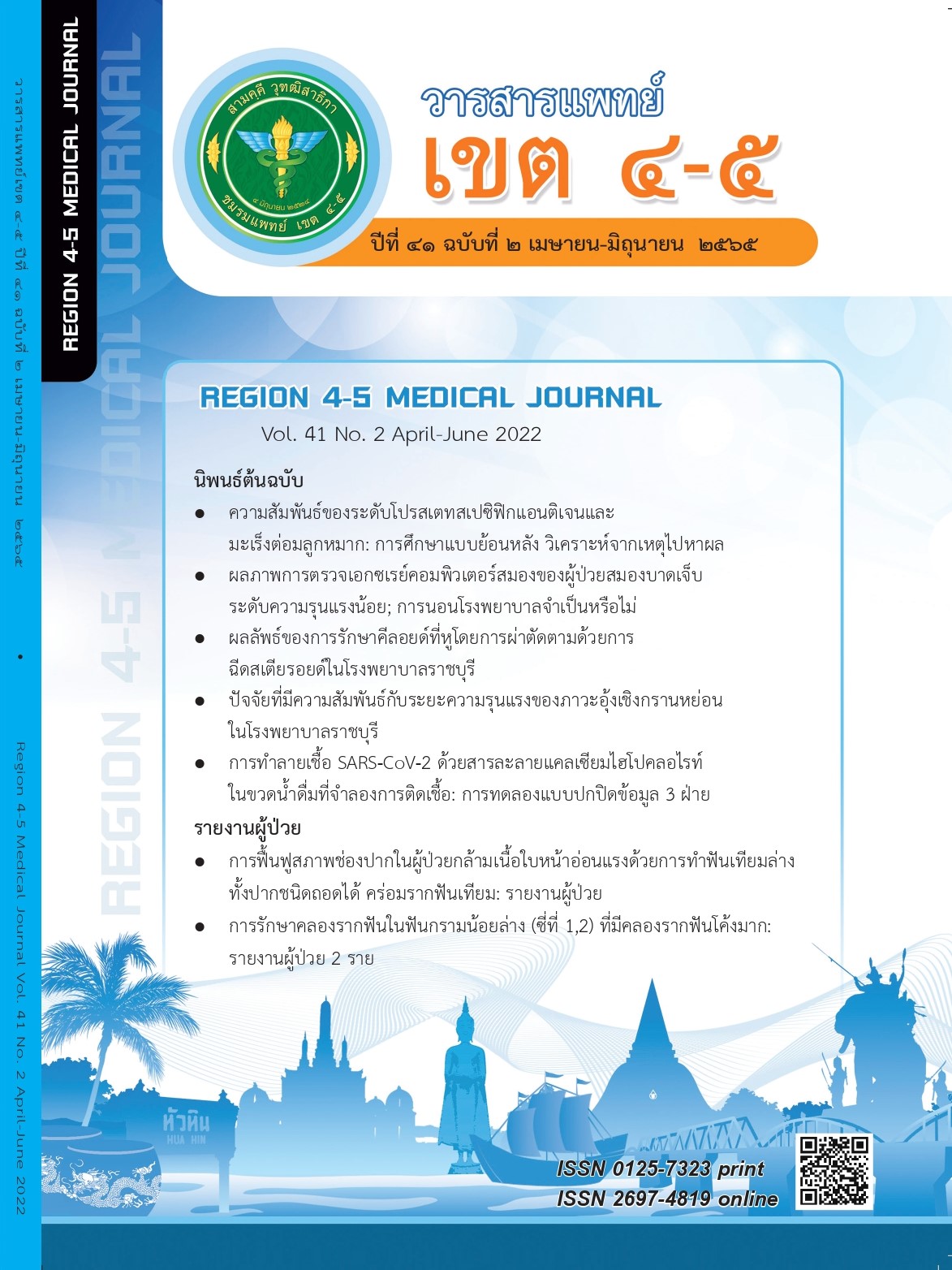การฟื้นฟูสภาพช่องปากในผู้ป่วยกล้ามเนื้อใบหน้าอ่อนแรงด้วยการทำฟันเทียมล่างทั้งปากชนิดถอดได้คร่อมรากฟันเทียม : รายงานผู้ป่วย
คำสำคัญ:
การฟื้นฟูสภาพช่องปาก, กล้ามเนื้อใบหน้าอ่อนแรง, การใส่ฟันเทียมบทคัดย่อ
การใส่ฟันเทียมถอดได้ทั้งปากในผู้ป่วยกล้ามเนื้อใบหน้าอ่อนแรงมักพบปัญหาการใช้งาน เนื่องจากกล้ามเนื้อที่อ่อนแรงมีผลต่อการควบคุมแนวการเคลื่อนที่ของขากรรไกรล่าง การยึดอยู่ ความมีเสถียรภาพ รวมทั้งความสวยงาม
กรณีศึกษา: ผู้ป่วยชายไทยอายุ 81 ปี มีประวัติกล้ามเนื้อใบหน้าด้านซ้ายอ่อนแรงมา 7 ปี แพทย์วินิจฉัยเป็น Left facial nerve palsy due to malignant otitis externa with osteomastoiditis ร่วมกับหูซ้ายหนวก ได้รับการรักษาด้วยยา และการผ่าตัดรักษาปัญหาเปลือกตาปิดไม่สนิท ต้องการใส่ฟันเทียมทั้งปาก การตรวจภายนอก พบใบหน้าไม่สมมาตร มุมปากด้านซ้ายตก มีน้ำลายไหลซึม ขากรรไกรล่างเยื้องไปด้านขวาเล็กน้อย ออกเสียงจากริมฝีปากคู่ (bilabial) และเสียงริมฝีปากล่าง-ฟันบน (labiodental) ไม่ชัดเจน ไม่สามารถเคลื่อนขากรรไกรล่างและกัดสบฟันตามคำบอกได้ การกัดสบฟันมีการเลื่อนไถล เนื่องจากอาการกล้ามเนื้อใบหน้าด้านซ้ายอ่อนแรง ผู้ป่วยได้รับการรักษาด้วยการพิมพ์ปากด้วยอัลจิเนต ต่อมาพิมพ์ปากครั้งสุดท้ายพร้อมทำการปั้นขอบด้วยวัสดุพิมพ์ปากซิลิโคน หลังจากนั้นทำการลองขี้ผึ้งในปาก จัดเรียงระนาบปลายฟันของฟันหน้าบน เนื่องจากผู้ป่วยไม่สามารถทำซ้ำ ตำแหน่งการกัดฟันและควบคุมแนวทางการเคลื่อนที่ของขากรรไกรล่างได้ ทำให้การประเมินมิติแนวดิ่งของการสบฟัน และความสัมพันธ์ของขากรรไกรทำได้ยาก ต้องช่วยประคองขากรรไกรล่างระหว่างหาความสัมพันธ์ดังกล่าว จากนั้นทำการเรียงฟันตามทฤษฎีการสบด้านลิ้น และนัดผู้ป่วยลองฟัน พร้อมเพิ่มขี้ผึ้งเพื่อขยายขอบด้านใกล้แก้มฟันบน ด้านซ้ายเพื่อช่วยพยุงกล้ามเนื้อ เมื่อผู้ป่วยพึงพอใจกับความสวยงาม การออกเสียง และการกัดสบฟันแล้วจึงเปลี่ยนขี้ผึ้งเป็นชิ้นงานอะคริลิกใส่ให้ผู้ป่วยใช้งาน นัดผู้ป่วยผ่าตัดฝังรากฟันเทียม เพื่อยึดฟันเทียมทั้งปากชิ้นล่าง โดยใช้รากฟันเทียมที่มีสิ่งยึดฟันเทียมโลเคเตอร์ (locator) งดใส่ฟันเทียมล่างอย่างน้อย 2 สัปดาห์ หลังการผ่าตัด 4 เดือน จึงทำการต่อ สิ่งยึดฟันเทียมโลเคเตอร์ (locator) แนะนำการดูแลรักษาฟันเทียมและส่วนของรากฟันเทียมแก่ผู้ป่วย นัดผู้ป่วยหลังทำ 2 สัปดาห์ เพื่อประเมินฟันเทียม รากเทียม และการทำความสะอาดช่องปากของผู้ป่วย หลังติดตามการรักษาที่ 1 และ 3 เดือน ผู้ป่วยพึงพอใจกับฟันเทียมชุดนี้ ทั้งในแง่ประสิทธิภาพในการเคี้ยวอาหาร ความสวยงาม และการยึดอยู่ ไม่มีแผลกดเจ็บ สรุปได้ว่า การใส่ฟันเทียมล่างทั้งปากที่รองรับด้วยรากฟันเทียม ในผู้ป่วยที่มีกล้ามเนื้อใบหน้าอ่อนแรง และมีการสูญเสียฟันล่างในช่องปากทั้งหมดรายนี้ ทำให้ผู้ป่วยมีสุขภาวะที่ดี
เอกสารอ้างอิง
Adell R, Eriksson B, Lekholm U, et al. Long term follow up study of osseointegrated implants in the treatment of totally edentulous jaws. Int J Oral Maxillofac Implants 1990;5(4):347–59.
Lenkholm U, Steenberhe DV, Herrmann I. Osseointegrated implants in the treatment of partially edentulous jaws: A prospective 5 year multicenter study. Int Oral Maxillofac Implants 1994;9(6):627–35.
Romero-Pérez MJ, Mang-de la Rosa MdR, López-Jimenez J, et al. Implants in disabled patients: a review and update. Med Oral Patol Oral Cir Bucal 2014;19(5):e478–82.
Muthuvignesh J, Kumar NS, Reddy DN, et al. Rehabilitation of Bell’s palsy patient with complete dentures. J Pharm Bioallied Sci. 2015;7(Suppl 2):S776–8.
Rajapur A, Mitra N, Prakash VJ, et al. Prosthodontic Rehabilitation of Patients with Bell’s Palsy: Our Experience. J Int Oral Health. 2015;7(Suppl 2):77–81.
Godavarthi SS, Sajjan S, Raju R, et al. Extended buccal flange technique to manage bells palsy patient with complete denture. International Journal of dental clinic. 2012;6:58-60
Kaur S, Suman N, Singh K, et al. Concept In Management Of Edentulous Bell’s Palsy Patient-A Case Report. Indian Journal of Dental Sciences. 2014;6:60–1
Lazzari JB. Intraoral splint for support of lips in Bells palsy. J Prosthet Dent. 1955;5: 579–81.
Larsen SJ, Carter JF, Abrahamian HA. Prosthetic support for unilateral facial paralysis. J Prosthet Dent 1976;35:192–201.
Carlsson GE. Implant and root supported overdentures - a literature review and some data on bone loss in edentulous jaws. J Adv Prosthodont 2014; 6(4):245–52.
Chee W, Jivraj S. Treatment planning of the edentulous mandible. Br Dent J 2006; 201(6):337–47.
Chee GH, Nedzeski JN. Facial nerve grading systems Facial Plast Surg 2000;16(4):315–24.
Heckmann SM, Heckmann JG, Weber HP. Clinical outcomes of three Parkinson´s disease patients treated with mandibular implant overdentures. Clin Oral Implants Res 2000;11(6):566–71.
Véron C, Chanavaz M, Ferri J, et al. A panorama of current materials for osseous application in maxillofacial surgery and oral implantology. Revue de stomatologie et de chirurgie maxillo-faciale. 1995;96(4):274–81.
Bishara SE. Textbook of Orthodontics. New York: W.B.Saunders company; 2001.
Robert G, Anderson MD. Facial nerve disorders and surgery. Sel Read Plast Surg 2006;10:1–41.
Malik NA. Facial nerve and motor disturbances of the face and jaws In: Malik NA, editor. Text Book of Oral and Maxillofacial Surgery New Delhi: Jaypee Brothers Medical Publishers 2008. p. 719–21.
Slavkin HC. The significance of a human smile: Observations on Bell’s palsy J Am Dent Assoc 1999;130(2):269–72
Inada M, Yamazaki T, Shinozuka O, et al. Complete denture treatments for a cerebral palsy patient by using a treatment denture. A case report J Med Dent Sci 2002;49(2):171–7.
Becker CM, Swoop CC, Guckes AD. Lingualized occlusion for removable prosthodontics J Prosthet Dent 1977;38(6):601–8.
Mericske-Stern RD, Taylor TD, Belser U. Management of the edentulous patient. Clin Oral Implants Res 2000;11:108–25.
Meijer HJ, Raghoebar GM, Van ‘t Hof MA. Comparison of implant‐retained mandibular overdentures and conventional complete dentures: a 10‐year prospective study of clinical aspects and patient satisfaction. Int J Oral Maxillofac Implants. 2003;18(6):879–85.
Meijer HJ, Raghoebar GM, Batenburg RH, et al. Mandibular overdentures supported by two or four endosseous implants: a 10‐year clinical trial. Clin Oral Implants Res. 2009;20(7):722–8.
Cune M, Burgers M, Kampen Fv, et al. Mandibular overdentures retained by two implants: 10‐year results from a crossover clinical trial comparing ball‐socket and bar‐clip attachments. Int J Prosthodont. 2010;23(4):310–7.
Siddharth B, Meena AA, Vidya C. Guidelines for treatment planning of mandibular implant overdenture. Journal of Dental Implant. 2014;4:86–90.
Patel PB. Narrow-diameter implants: A minimally invasive solution for overdenture treatment - part 2. Aust Dent Pract. 2013;24(2):180–186.
Omura AJ, Latthe V, Marin MM, et al. Implant-assisted removable partial dentures: practical considerations. Gen Dent 2016;64(6):38–45.
Smith RA, Berger R, Dodson TB. Risk factors associated with dental implants in healthy and medically compromised patients. Int J Oral Maxillofac Implants 1992;7(3):367–72.
Rogers JO. Implant-stabilized complete mandibular denture for a patient with cerebralpalsy. Dent Update 1995;22(1):23–6.
ดาวน์โหลด
เผยแพร่แล้ว
รูปแบบการอ้างอิง
ฉบับ
ประเภทบทความ
สัญญาอนุญาต

อนุญาตภายใต้เงื่อนไข Creative Commons Attribution-NonCommercial-NoDerivatives 4.0 International License.
ลิขสิทธิ์บทความเป็นของผู้เขียนบทความ แต่หากผลงานของท่านได้รับการพิจารณาตีพิมพ์ลงวารสารแพทย์เขต 4-5 จะคงไว้ซึ่งสิทธิ์ในการตีพิมพ์ครั้งแรกด้วยเหตุที่บทความจะปรากฎในวารสารที่เข้าถึงได้ จึงอนุญาตให้นำบทความในวารสารไปใช้ประโยชน์ได้ในเชิงวิชาการโดยจำเป็นต้องมีการอ้างอิงถึงชื่อวารสารอย่างถูกต้อง แต่ไม่อนุญาตให้นำไปใช้ในเชิงพาณิชย์




